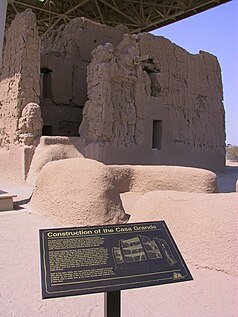Casa Grande Ruins National Monument
| Casa Grande Ruins National Monument | ||
|---|---|---|
| Casa Grande Ruin with the striking superstructure | ||
|
|
||
| Location: | Arizona , United States | |
| Next city: | Phoenix (Arizona) | |
| Surface: | 1.9 km² | |
| Founding: | June 22, 1892 | |
| Visitors: | 77,347 (2010) | |
| View of the Casa Grande from 1892 | ||
| Close-up and schematic representation of the Casa Grande | ||
Casa Grande Ruins National Monument is a memorial of the type of National Monuments in the State of Arizona - about 80 kilometers south of Phoenix . It houses the remains of a settlement of the Hohokam people that was built around the year 1200 . The namesake and center of the area is Casa Grande (Spanish for large house ) - the largest known building from the Hohokam era, but which was probably built much later.
history
From around the year 300 nomadic hunters and gatherers had developed into the Hohokam people , who settled in the river valleys of the Gila and Salt Rivers and established their first permanent settlements. The Hohokam began to farm and built irrigation canals around the rivers. Away from the rivers, rainwater was collected for irrigation and channeled into the fields or dug for groundwater.
At the same time, a brisk trade between the peoples of the southwest began to develop. Settlements now also emerged on trade routes that at that time stretched into what is today California , the Great Plains , the Colorado Plateau and into what is now Mexico . From the middle of the 12th century, a structural change in the Hohokam culture began. People left the small, scattered villages and concentrated in larger, mostly riverside settlements, to which Casa Grande is counted.
Little is known about the end of the Hohokam culture. When the Spanish missionary Padre Eusebio Kino passed the Casa Grande settlement in 1694, he found it long abandoned. Members of the Pima people , whom he met nearby, told him that the settlement was once inhabited by their ancestors, whom they call Ho-ho-kahm . Ho-ho-kahm means " everyone has gone " in the Pima language .
The ruins of Casa Grande
Today's National Monument consists of a number of ruins surrounded by a rectangular wall. Casa Grande is by far the largest and best preserved structure in the park. With a few exceptions, the remaining ruins of the park consist of waist-to-head-high wall remains.
All of the historic structures in Casa Grande Ruins National Monument are made of a material called caliche . It is a unique, concrete-like mixture of sand , clay and limestone that was developed and perfected by the Hohokam. The ingredients were mixed into caliche mud and applied layer by layer to the planned walls. Ceiling elements were made from fir, pine and juniper wood, which were cut down about 60 miles (approx. 100 km) upstream on the Gila River and transported on the river to the settlement.
The Casa Grande
Casa Grande got its name from early Spanish explorers, for whom the size of the building was unbelievable. Today this is always given as a four-story structure (building with four floors) with a side length of 60 feet (approx. 18.3 m). The completion of the building is estimated to be around the year 1350.
The structure deserves special attention due to several structural features that indicate the Hohokam's excellent astronomical knowledge. The walls of the square building are precisely aligned with the cardinal points. A circular hole in the upper area of the western wall lets the light fall in at a certain point at the time of sunset at the summer solstice . Several other openings in the walls are aligned with other specific positions of the sun and moon. This astronomical knowledge was used, among other things, to determine the right time for sowing, harvesting and religious festivals.
The National Monument
In order to protect and preserve Casa Grande as a unique historical building, the Casa Grande Ruin Reservation was established on June 22, 1892 by President Benjamin Harrison . Casa Grande and an area of approximately 194 hectares surrounding the structure were the first prehistoric and cultural site in the United States .
On August 3, 1918, the area was declared a National Monument by President Woodrow Wilson . From 1930, at the instigation of the US Congress , the facility was finally called Casa Grande Ruins National Monument . In 1926 the area was reduced to the current size of around 191 hectares. Today Casa Grande is under the administration of the National Park Service .
The striking superstructure, which protects Casa Grande from the weather to this day, dates back to 1932 and is based on designs by Frederick Law Olmsted, Jr. , the son of the well-known landscape architect Frederick Law Olmsted , who was responsible for the design of Central Park in New York was responsible.
The visitor center also displays artifacts of the Hohokam culture found in the nearby Hohokam Pima National Monument . This is on private property and is not accessible to the public.
Web links
- National Park Service: Casa Grande Ruins National Monument (official site; English)
- Online version of the story of Casa Grande by A. Berle Clemensen (Engl.)




